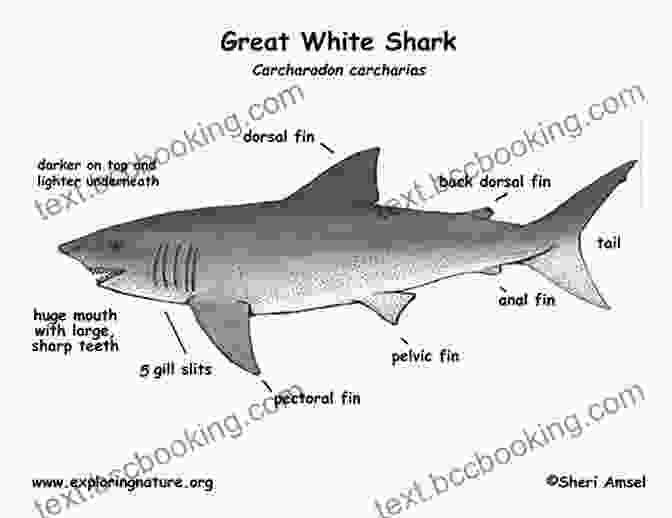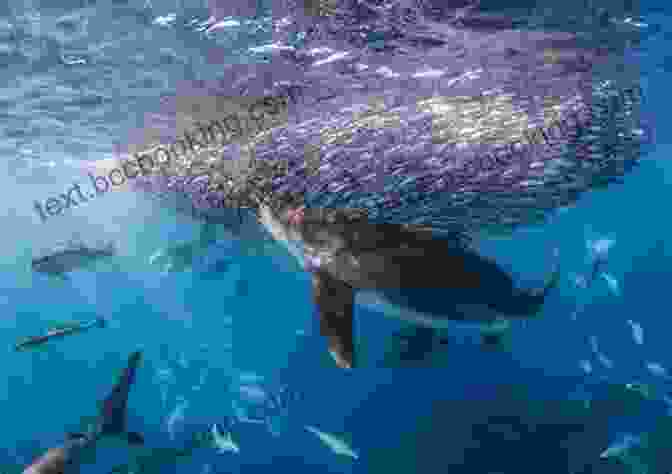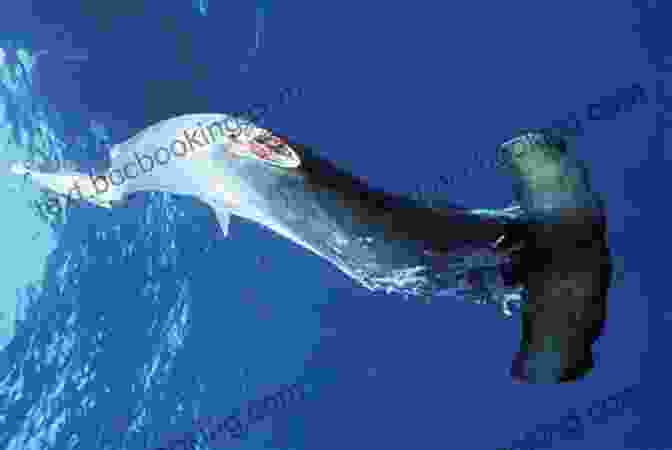Educational Information About Sharks

Sharks, the apex predators of the oceans, have captivated the human imagination for centuries. These magnificent creatures play a crucial role in maintaining the health and balance of marine ecosystems. This article aims to provide comprehensive educational information about sharks, covering their biology, ecology, behavior, and significance in the aquatic environment.
Biological Characteristics

4.9 out of 5
| Language | : | English |
| File size | : | 23584 KB |
| Text-to-Speech | : | Enabled |
| Screen Reader | : | Supported |
| Enhanced typesetting | : | Enabled |
| Print length | : | 53 pages |
| Lending | : | Enabled |
Sharks belong to the class Chondrichthyes, which includes fish with cartilaginous skeletons. They possess a unique set of physical and physiological adaptations that enable them to thrive in diverse marine habitats.
Body Structure
- Streamlined Body: Sharks have a torpedo-shaped body that reduces drag and allows for efficient swimming.
- Dorsal Fins: Most sharks have two dorsal fins that provide stability and maneuverability.
- Pectoral and Pelvic Fins: These paired fins help sharks navigate, turn, and control their movements.
- Caudal Fin: The tail fin propels sharks forward and provides balance.
- Teeth: Sharks have rows of sharp, replaceable teeth that are adapted for slicing through prey.
- Scales: Their skin is covered with small, tooth-like scales called placoid scales.
Sensory Systems
Sharks have highly developed sensory systems that allow them to detect prey and navigate their surroundings.
- Vision: Sharks have excellent vision, especially in low-light conditions.
- Smell: Their olfactory bulbs are highly sensitive to detecting blood and other chemical cues in the water.
- Hearing: Sharks can detect low-frequency sounds and vibrations.
- Electroreception: Ampullae of Lorenzini enable sharks to sense electrical fields generated by prey.
- Lateral Line System: This sensory system detects changes in water pressure and helps sharks navigate.
Ecology and Behavior

Sharks inhabit a wide range of marine environments, from coastal waters to the open ocean. Their ecological roles and behaviors vary depending on their species and habitat.
Feeding Habits
- Predators: Sharks are primarily predators, feeding on a variety of marine animals, including fish, seals, turtles, and other sharks.
- Carnivores: Their diet is predominantly carnivorous, with some species specializing in specific prey.
- Foraging Strategies: Sharks employ various foraging strategies, such as ambush, pursuit, and scavenging.
Social Behavior
- Solitary: Most shark species are solitary creatures, but some form social groups for specific purposes, such as mating or hunting.
- Schooling: Certain shark species, such as nurse sharks, form large aggregations for protection or feeding.
- Migration: Some sharks migrate long distances to follow prey or find suitable habitats.
Reproduction
- Ovoviviparity: Many shark species are ovoviviparous, meaning the eggs develop and hatch inside the mother's body.
- Viviparity: Some sharks give birth to live young, which are fully developed within the mother's body.
- Egg-laying: A few species of sharks lay eggs in shallow waters or attach them to rocks.
Significance and Conservation

Sharks play a critical role in maintaining the health of marine ecosystems. They are apex predators that help control populations of other marine animals.
Ecological Significance
- Population Control: Sharks regulate populations of prey species, preventing overpopulation and imbalances in the food web.
- Habitat Maintenance: Sharks help maintain the health of coral reefs and seagrass beds by controlling populations of herbivores.
- Nutrient Cycling: Sharks contribute to nutrient cycling by consuming dead or dying organisms and returning nutrients to the marine environment.
Threats and Conservation
Unfortunately, sharks face numerous threats that jeopardize their survival.
- Overfishing: Sharks are often targeted for their meat, fins (which are used in shark fin soup),and liver oil.
- Shark Finning: This barbaric practice involves removing the shark's fins and discarding the body back into the ocean.
- Bycatch: Sharks are frequently caught as bycatch in fishing operations targeting other species.
- Habitat Loss: Coastal development and pollution can destroy or degrade shark habitats.
- Climate Change: Rising ocean temperatures and acidification can impact shark populations and habitats.
Conservation efforts are crucial to protect sharks and ensure their survival. These efforts include:
- Fisheries Management: Sustainable fishing practices can reduce the impact of fishing on shark populations.
- Habitat Protection: Designating and protecting marine reserves can provide safe habitats for sharks.
- Education: Raising awareness about the importance of sharks and the threats they face is essential.
- Research: Ongoing research helps scientists better understand shark biology, behavior, and conservation needs.
Sharks are fascinating and essential creatures that play a vital role in marine ecosystems. Understanding their biology, ecology, and significance is crucial for their conservation and the overall health of our oceans. By embracing educational initiatives and supporting conservation efforts, we can ensure that sharks continue to thrive in the depths of the ocean for generations to come.
References
- Compagno, L. J. V., Dando, M., & Fowler, S. (2005). Sharks of the world. Princeton University Press.
- Ebert, D. A. (2018). Sharks, rays, and chimaeras of California. University of California Press.
- Helfman, G., Collette, B. B., Facey, D. E., & Bowen, B. W. (2009). The fishes: Diversity, biology, and evolution. John Wiley & Sons.
- IUCN Red List of Threatened Species. (2023). https://www.iucnredlist.org/
- Shark Stewards. (2023). https://www.sharkstewards.org/
4.9 out of 5
| Language | : | English |
| File size | : | 23584 KB |
| Text-to-Speech | : | Enabled |
| Screen Reader | : | Supported |
| Enhanced typesetting | : | Enabled |
| Print length | : | 53 pages |
| Lending | : | Enabled |
Do you want to contribute by writing guest posts on this blog?
Please contact us and send us a resume of previous articles that you have written.
 Book
Book Novel
Novel Page
Page Chapter
Chapter Text
Text Story
Story Genre
Genre Reader
Reader Library
Library Paperback
Paperback E-book
E-book Magazine
Magazine Newspaper
Newspaper Paragraph
Paragraph Sentence
Sentence Bookmark
Bookmark Shelf
Shelf Glossary
Glossary Bibliography
Bibliography Foreword
Foreword Preface
Preface Synopsis
Synopsis Annotation
Annotation Footnote
Footnote Manuscript
Manuscript Scroll
Scroll Codex
Codex Tome
Tome Bestseller
Bestseller Classics
Classics Library card
Library card Narrative
Narrative Biography
Biography Autobiography
Autobiography Memoir
Memoir Reference
Reference Encyclopedia
Encyclopedia Matthew Stavros
Matthew Stavros Steven Heller
Steven Heller Martin Orwin
Martin Orwin Marianne Hering
Marianne Hering Sobia Publication
Sobia Publication Paula Deen
Paula Deen Stuart Robson
Stuart Robson Michelle Down
Michelle Down Maria Isabel Sanchez Vegara
Maria Isabel Sanchez Vegara Mary S Morgan
Mary S Morgan Martina Carracedo
Martina Carracedo Mark Huber
Mark Huber Mary Reese Paul
Mary Reese Paul Mark Chesnut
Mark Chesnut Mary Quinlan Mcgrath
Mary Quinlan Mcgrath Shaunna Sanders
Shaunna Sanders Marrae Kimball
Marrae Kimball Mark C Tibergien
Mark C Tibergien Mary Jo Ignoffo
Mary Jo Ignoffo Tom Gelb
Tom Gelb
Light bulbAdvertise smarter! Our strategic ad space ensures maximum exposure. Reserve your spot today!

 José MartíFly Fishing Guide to the Upper Delaware River: Your Gateway to Unforgettable...
José MartíFly Fishing Guide to the Upper Delaware River: Your Gateway to Unforgettable...
 Dustin RichardsonMastering Project Management: A Comprehensive Guide to Traditional, Agile,...
Dustin RichardsonMastering Project Management: A Comprehensive Guide to Traditional, Agile,...
 Alex FosterAn Autobiography of John Muir: Embark on an Unforgettable Odyssey Through the...
Alex FosterAn Autobiography of John Muir: Embark on an Unforgettable Odyssey Through the... Garrett PowellFollow ·3.2k
Garrett PowellFollow ·3.2k Guy PowellFollow ·19.6k
Guy PowellFollow ·19.6k Ed CooperFollow ·13.3k
Ed CooperFollow ·13.3k Oliver FosterFollow ·5.1k
Oliver FosterFollow ·5.1k Colton CarterFollow ·12.8k
Colton CarterFollow ·12.8k Bob CooperFollow ·12.3k
Bob CooperFollow ·12.3k Fernando BellFollow ·10.1k
Fernando BellFollow ·10.1k Hank MitchellFollow ·14.8k
Hank MitchellFollow ·14.8k

 Larry Reed
Larry ReedGwendy's Final Task: A Thrilling Conclusion to a Timeless...
Prepare to be...

 Victor Turner
Victor TurnerHow FDR Defied Polio to Win the Presidency
Franklin D. Roosevelt is...

 Edwin Cox
Edwin CoxWinner RGS BBC Journey of a Lifetime Award: An Inspiring...
In the heart of the world's...

 Griffin Mitchell
Griffin MitchellEverything You Need to Know, You Learned From Mister...
Mister Rogers' Neighborhood was a beloved...

 Beau Carter
Beau CarterSeasons of Terror: A Spine-Tingling Odyssey into the...
In the realm of horror...
4.9 out of 5
| Language | : | English |
| File size | : | 23584 KB |
| Text-to-Speech | : | Enabled |
| Screen Reader | : | Supported |
| Enhanced typesetting | : | Enabled |
| Print length | : | 53 pages |
| Lending | : | Enabled |







